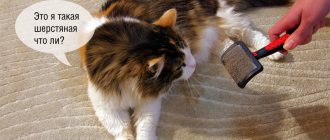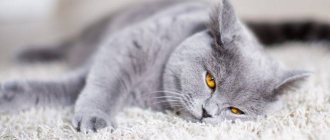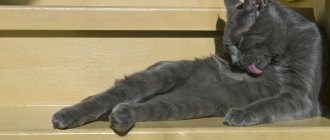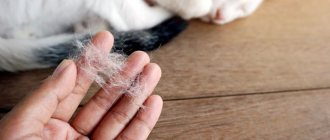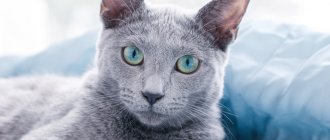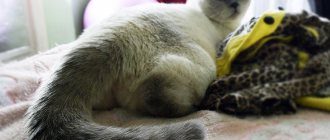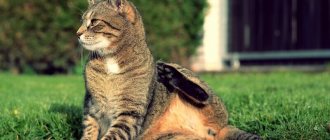Shedding is a normal process. Thanks to it, a gradual change of coat occurs. For example, if the animal is hot (summer is approaching or the heating season in the apartment).
Without shedding, the pet will be very hot, which is why some of the hairs fall out.
However, in some cases, such a change in coat is not associated with an increase in temperature in the cat’s environment.
Or the amount of hair falling out is too large. Then the owner should be wary, because severe shedding can be a symptom of a disease.
Physiology
At different periods of its existence, a cat moves differently. The resulting calories from a small kitten are spent on the growth of bones and muscles; the remaining calories are required for play.
The body of older cats may dry out due to age and for some other reasons, including:
- illnesses and stress;
- lack of vitamins;
- lost teeth;
- parasites.
Owners of older cats should closely monitor their condition and take them to the veterinarian if necessary.
Other signs
Breathing becomes frequent or, conversely, rare and cautious (if painful), wheezing, wheezing, coughing, and shortness of breath appear. Shortness of breath in a cat can be caused by increased physical activity, asthma, inflammation or emphysema, which, in turn, is a consequence of poisoning. Difficulty breathing is observed with pleurisy, heart failure, anemia, and worms. In older cats, a sign of heart failure may be a cough.
We suggest you read: What does it mean if a cat does not eat, refuses water, and constantly lies lethargic?
Lymphatic system. Enlarged lymph nodes, as a rule, indicate the presence of an inflammatory process. Most often, the submandibular lymph nodes are involved in this process, so you should learn to find and feel them.
Increased thirst may be associated with a cold, diabetes, dropsy, renal failure, or kidney disease, and if it is accompanied by physical weakness and odor from the mouth, this most likely indicates uremia.
HOW TO DETECT A CAT'S PREGNANCY?
Vomiting develops in response to poisonous herbs entering the stomach and in general during poisoning, helminthic infestation, and travel in transport. Vomiting and increasing physical weakness in combination with constipation indicate intestinal obstruction and the presence of a foreign body in the intestine.
Increased salivation occurs when the tongue and oral cavity are damaged, when a foreign body enters the esophagus, during heat and sunstroke, during poisoning and some liver diseases. It can also be a symptom of such a terrible disease as rabies.
But these signs of diseases, as a rule, do not appear all at the same time: usually one sign is most pronounced, and the rest accompany it (in one combination or another). The improvement in the cat’s well-being and recovery can be judged after the disappearance of all painful manifestations characteristic of a particular disease.
The posture of a cat can tell you a lot. A healthy animal rests or sleeps in a relaxed position, with its torso straightened and limbs stretched out. A sick cat takes a forced position that helps reduce pain or any discomfort. In particular, with heart disease, a cat stands with its forelimbs spread wide apart - this makes breathing easier;
The above symptoms manifest themselves to varying degrees, and their combination also varies widely. If you are concerned about anything in your cat's physical condition or behavior, call your veterinarian or the nearest veterinary clinic (make sure to always have these numbers at hand or in a visible place). A telephone consultation may be sufficient to help your pet.
Normal weight
On average, an adult animal should weigh from 3 to 8 kg. Such a cat drinks a lot of fluids, eats, and leads an active life.
The doctor determines the degree of fatness based on the following criteria:
- Exhaustion - the cat has no subcutaneous layer, protruding ribs, a retracted abdomen, and a thin, dense tail.
- Disadvantage - bones and ribs are visually visible, but there is already a small amount of fat. The cat's figure resembles an hourglass.
- The ideal is the presence of a thin subcutaneous layer, the ribs are not visible, but can be easily felt, the body size is proportional.
- Excess – under a thick layer of fat it is almost impossible to feel the bones. If you look at the cat from above, the back appears broad.
- Dangerous excess - bones cannot be felt, folds are present on all parts of the body.
Weight categories (table)
Below are the average weight categories of cats, from which you can determine what type the pet belongs to. However, it is worth taking into account the breed characteristics of cats.
- Underweight (wasting)
The ribs, joints and pelvic bones are clearly visible in both long-haired and short-haired cat breeds. Lack of fat layer in the chest area.
- Normal limit (thinness)
The ribs, joints and pelvic bones are visible, but only in short-haired breeds. The waist is clearly visible. There is a thin layer of fat in the chest area.
- Ideal weight
The ribs, joints and pelvic bones are not visible, but can be felt. Good proportions with a visible waist. There is a thin layer of fat in the chest and abdomen area.
- Overweight
The bones can be felt, but with great difficulty. The waist is difficult to distinguish. Fat layers are clearly palpable.
- Obesity
The bones cannot be felt due to the thick fat layer. The waist is not visible, the volume of the abdomen is significantly increased.
Why is a cat losing weight?
Pathology
If a cat eats a lot of food, but loses weight, there are several reasons:
- Presence of parasites . Worms or helminths can destroy a pet’s body from the inside. Even though the cat eats a lot of food, he continues to lose weight. A cat can become infected with helminths through dirty shoes, unwashed hands, or a dirty litter tray. You can get rid of parasites only by using special medications (treatment is carried out for at least six months).
- Diseases of internal organs. In diseases, there are two mechanisms for losing weight: lack of appetite and small doses of food consumed; and the process of digestion and absorption of food is disrupted. Endocrine diseases and pathologies of the digestive system lead to weight loss even when eating enough food. Associated symptoms are apathy, hair loss, diarrhea or constipation, etc.
- Stress. If an animal is stressed for a long time, it may lose weight even with a good appetite. If a cat is depressed, there may be no appetite at all, which also affects weight. Well, you need to wait for the cat to return to normal; neurological disorders require treatment and sedative medications.
- Infections. Infectious diseases are always accompanied by weight loss. All because the pet refuses food and water. The most common diseases are calcivirosis, rhinotracheitis, viral peritonitis, and panleukopenia. Often these diseases lead to the death of the pet.
- Tumors. Any malignant neoplasms can cause exhaustion in a cat. The animal has no appetite, hair falls out, and vomiting and diarrhea are possible.
- Allergy. If there is an allergic reaction, the cat may lose its sense of smell, making it difficult for it to perceive food. She will eat less and lose weight.
Don't forget about vaccinations. Most people believe that if an animal lives in a house, it cannot get sick. We can bring various viruses and infections with clothes or shoes, and cats living at home are more susceptible to them than street cats.
Physiological reasons
The conditions in which the animal is kept also matters. Here the reasons for weight loss can be:
- Mating period. During this time, pets may forget about food and lose body weight. At the end of the period of “festivities” the animal returns to normal. Changes in temperature. In winter, the cat accumulates fat; in summer, the fat is absorbed.
- Pregnancy . During pregnancy, a cat's appetite is always good, but as soon as she starts feeding kittens, she may lose weight. Everything will fall into place as soon as the feeding period is over.
- Feed. A cat's weight directly depends on the quality of food consumed. You cannot suddenly change her diet from dry food to homemade food. Due to menu changes, the pet always loses weight.
Most owners do not check the weight standards for their pet, taking into account its age and breed.
Causes of severe hair loss
- When the house is very hot, the air is too dry, and the light bulbs are almost constantly burning yellow, the cat sheds a lot. This is good and cozy for a person, but such conditions are not suitable for a pet. That is why molting is an opportunistic reaction.
- Often a cat sheds due to a lack of vitamins. This may be due to an incorrectly formulated diet, when there are practically no useful substances in the cat’s menu. This is either low quality food or the same products day after day. The fur is the first to react to hypovitaminosis; if you don’t catch it in time, much more serious complications will arise.
- Inappropriate cosmetics (shampoo, conditioner). Even a person experiences dandruff or hair loss if he uses cosmetics that are intended for a different type of hair and skin. Why can't a cat have the same reaction?
- Allergy. What does it develop into: food, medicine, household chemicals, plants, insect bites, dust and much more. But if a cat suffers from an allergic reaction, then it not only sheds, but also itches, and the nose and eyes begin to run. The cat will begin to sneeze, maybe even cough, and if the pet is not helped, every day it will get worse and worse.
- Parasites. Both cutaneous (fleas, lice) and intestinal helminths can lead to severe hair loss in a cat. If cutaneous worms act “directly,” then intestinal worms act “indirectly,” releasing toxins during their life. These toxins become an allergen for the body of a healthy pet.
- Fungi. The most well-known disease is microsporia (in common parlance - lichen). It can easily switch from a cat to a human. Of course, in this case, the cat does not shed completely, but only in certain areas, but still you should not write off this reason.
- Stress. Cats have plenty of external stimuli that lead to frustration. When animals are nervous, they shed heavily, may itch, sleep poorly, or, on the contrary, for a suspiciously long time and soundly (as if they have disconnected from the outside world). The cat may begin to lose weight.
- Skin disease, for example, dermatitis. Burns (chemical, solar, thermal) can also lead to increased hair loss (but only on the affected area of tissue, and not throughout the body).
- Inflammatory processes (hidden or obvious). With them, the animal’s body weakens, all efforts are spent on the pet’s recovery and restoration of the functions of the affected organs. Dull fur, which begins to thin out over time, can “tell” about the beginning of inflammation. The cat needs veterinary care, even if you think everything is fine with him.
- Predisposition. We must not forget about her. The most susceptible to heavy shedding is a short-haired cat, but with a very thick undercoat (for example, a British cat).
Dangerous and safe symptoms
You shouldn’t worry when your cat is thinner if he has:
- a certain breed - Bengal, Somali, Abyssinian;
- active lifestyle;
- age more than 10 years;
- change of lifestyle (moving, new litter box, new owner).
If the pet is in a calm state, but is suddenly losing weight, then the symptoms of the disease may be:
- drowsiness;
- At first the cat led an active life, then suddenly became lethargic and apathetic;
- loss of a large amount of hair;
- blood in excrement;
- nausea, constipation or diarrhea;
- heat;
- blanching of the mucous membranes.
What causes active hair shedding?
If pets live in an apartment, are deprived of free range, fresh air, and are always in a closed space, then the process of hair loss in animals is a natural phenomenon.
A cat sheds without health problems once or twice a year, in late spring or summer, and also in autumn or early winter. With the onset of heat, the cat provides itself with a comfortable existence at high temperatures. In the autumn, the cat loses its fur in order to acquire a new, warmer coat, which is important in cold times. In other months, the whiskers stop moulting. The domestic cat loses its established rhythm, and the signal to shed its old fur may not be the proper time of year, but the beginning of the heating season. Dry and warm air in the room negatively affects the skin of the cat, the pet noticeably loses weight, ceases to lead an active lifestyle, sleeps more and begins to shed heavily. This moment creates significant discomfort for both the animal and the household. The cat is constantly itching, trying to get rid of unnecessary hair, and hairballs begin to scatter throughout the home.
Other causes of hair loss
The surgery may cause hair loss.
- Pet after sterilization or castration. A castrated or sterilized cat reacts sharply to surgical intervention; the animals' body processes are disrupted, including fur regeneration.
- Incorrectly selected hygiene cosmetics for the animal. Using human shampoo, an allergy to a certain drug can cause increased shedding, even if the cat is smooth-haired, for example, a Siamese or a British cat.
- Poor quality care. If the owners are too lazy to comb their pet, the animal’s fur becomes dull, tangled, tangles form and shedding begins, which is much more difficult to combat than to prevent with timely and high-quality care.
- Age. An old cat sheds a lot, much more than a young feline. A balanced diet will help reduce hair loss; cats should be given plenty of protein foods and mineral supplements.
- Depending on the breed. As a rule, long-haired cat breeds, such as Persians, Scots, Angoras, and Britons, shed especially often and very heavily, although short-haired ones are also susceptible to this process.
- Poor nutrition. You need to feed your cat high-quality food; if your pet is constantly molting, it won’t be superfluous to buy food with protein and vitamins. A balanced diet is a regular thing; food should be healthy both during shedding and after the unpleasant process is over. The diet should contain fewer preservatives; veterinarians do not encourage a mono-diet.
Treatment
In case of physiological reasons, no measures should be taken . But if there is a pathology, you need to get rid of it as soon as possible.
The cat must be shown to a veterinarian, who will order an examination, blood and stool tests, and x-rays. Once the picture becomes clear, the doctor may prescribe:
- medicines;
- vitamin supplements;
- change of diet;
- change of activity mode.
Diagnosis of the causes of exhaustion in a cat
Based on the fact that there are a large number of reasons that can cause exhaustion in a cat, the owners of an exhausted cat will need to contact a veterinarian at their veterinary clinic. Veterinary specialists will conduct a clinical examination of your cat and collect a medical history.
- In order to exclude helminthic diseases, feces will be taken for examination in a veterinary laboratory for worms.
- To exclude inflammatory processes and anemia in the cat, a complete clinical blood test will be performed.
- A complete biochemical blood test will be performed to determine the functioning of the liver, kidneys, protein and sugar levels in the blood.
- A urine test will allow your veterinarian to evaluate kidney function, look for protein in the urine, and sometimes detect infection.
- In order to exclude oncological diseases, the presence of foreign bodies in the gastrointestinal tract, fluid in the chest and abdominal cavity, an X-ray of the chest and abdominal cavity will be taken.
- Using an ultrasound of the abdominal cavity, a study of the liver, kidneys, pancreas, and the functional state of the intestines will be performed.
- Your older cat will have your thyroid hormone levels measured.
- Bile acid levels will be measured to assess liver function.
How to feed
If a cat loses body weight, the fault may lie with its owner, who incorrectly compiled his daily menu. There are rules, if followed, the cat’s weight will always be normal:
- Mixing dry food and homemade food is unacceptable. A cat develops one type of digestion, which is aimed either at “artificial” food or at natural food. When feeding dry food, your cat needs more fluid. If you change your diet frequently, your stomach will not be able to adapt in time, and you will begin to lose weight.
- Don't trust advertising. Such well-known brands as Whiskas and Kitiket are not a sign of quality. They are accessible to everyone, but contain attractions. These components are addictive. This is a serious burden for the pet’s stomach and intestines. You can extend your cat's life if you feed him food from a specialized store.
It is necessary to give preference to only one food option, otherwise, in addition to weight loss, various diseases may develop. This is natural food or branded industrial food.
ATTENTION! The packaging must be labeled holistic, premium and supreme. These are classes that indicate that all production standards have been met.
Diabetes
Diabetes mellitus is another common disease that affects cats. This endocrine disorder affects the pancreas's ability to produce insulin, a hormone needed to regulate blood glucose levels.
Signs of diabetes include weight loss, increased appetite, thirst and urination, and lethargy. Diabetes is usually treated with insulin and diet changes.
Other medications may be used. Some cats will even return to normal after several months of treatment.
Natural food
A cat's diet should contain two types of products: meat and fermented milk.
The meat diet must include beef, cut into small pieces. To get vitamins, you need to add vegetables or special additives to the meat. In pet stores you can buy special powders containing all the necessary vitamins.
ATTENTION! Fermented milk products include low-fat cottage cheese and kefir (1%). Cottage cheese should be on a cat’s menu 1-2 times a week.
Fattening the cat
To restore your cat to optimal condition, you need to change its diet. Veterinarians recommend adding high-protein food to it, but not from the economy segment. They provide minimal nutritional support and will not benefit your pet.
If the cat is very thin, then to get it in shape, you need to add natural products to the diet. Provide fresh, but lean meat (such as beef or turkey) daily. Make sure that the share of meat in the diet is about 50%.
To ensure optimal digestion, you need to add fresh vegetables to your meals:
- carrots,
- pumpkin,
- turnips, etc.
An equally valuable source of feeding animals is cereals, which contain rice and buckwheat in large quantities. It is strictly forbidden to give your cat raw eggs, onions, garlic, chocolate, alcohol, or yeast dough.
If you think your cat is too thin, do not waste time - contact your veterinarian. The sooner a diagnosis is made and treatment is prescribed, the sooner your pet will return to a full and healthy life!
Grass
If a cat is losing weight, its diet must include green grass. It is necessary to normalize the functioning of the digestive system. The herb contains manganese, zinc, pantothenic acid, and various vitamins that help the body get rid of parasites and strengthen the immune system.
Forcing your cat to intentionally eat more food can be dangerous. Excess weight increases the load, reduces the pet's activity and leads to the development of various diseases.
If you constantly monitor changes in your pet, you can notice the symptoms of the disease in time.
IMPORTANT! Monitor the animal’s weight and lifestyle, feed it the right food. This will not only improve your well-being, but also prolong its life.
Cat losing weight due to parasites
Helminths are a common cause of weight loss. Having become interested in why a cat is losing weight with a good appetite, the owner should examine the contents of the tray and feel the pet’s belly. In the presence of parasites, swelling is observed. Helminths are not always visible in feces. But their presence is indicated by the dark color and liquid consistency of the stool. Additional signs of infection are:
- cough;
increased salivation and tear production;
vomit;
Frequent scratching or licking of the area under the tail.
In the first stages, the animal can only lose weight without loss of appetite. It is advisable to show him to a veterinarian to confirm the diagnosis. The doctor will also prescribe the most suitable drug. Pet stores offer deworming products in the form of pieces of dry food. Despite their relative cheapness and ease of administration, they may not be effective enough. The veterinarian will prescribe the medicine in the appropriate form.
If a cat has become infected with intestinal parasites, the owner must thoroughly rinse the cat's tray, bed and other favorite places of the pet. It is advisable for the whole family to take preventive medications against helminths. To reduce the risk of infection, it is advisable not to let your cat go outside.
Thyroid problems
By entering a query about why a cat is losing weight, a person will see various articles about hyperthyroidism. The disease is characterized by excessive production of thyroid hormones. A common cause of organ activity is a benign tumor. Appetite remains or even increases, but weight decreases. Additional signs of the development of pathology are:
- strong thirst;
excessive activity;
nausea;
amyotrophy;
diarrhea.
The disease can develop in any breed. This is an age-related disorder - less than 6-10% of cases occur in cats under 10 years of age.
The symptoms of hyperthyroidism are similar to those of some other conditions that develop in older adults. These include diabetes, inflammation and bowel cancer, and kidney failure. Problems with the thyroid gland are indicated by an increased level of the hormone T4 in the blood. But in about 10% of cats it may be at normal levels. To rule out diabetes or kidney problems, a complete blood and urine test is performed.
Left untreated, hyperthyroidism will lead to heart problems and death. But, with timely treatment, the cat returns to normal life. Surgery is a radical solution. Due to its structure, the tumor is easy to localize and remove. But anesthesia can be dangerous for an older cat. In such cases, the animal is prescribed methimazole (Tapazole). The drug normalizes the production of hormones and can be administered orally or applied to the skin of the ears. Your cat's blood will be drawn regularly to check the effect of the medication.
An alternative solution is radioactive iodine. The drug accumulates in the thyroid gland, destroying overactive tissue. No anesthesia or surgery is required. The cat is in the hospital for 10-14 days until the radioactive element is removed from the body.
Stress and other reasons why a cat can lose weight
Nervous tension is a common answer to the question why a cat doesn’t eat well and is losing weight. When under stress, an animal may retain its appetite. But the food is less digestible or the pet becomes nauseous. During an attack, the cat tends to hide, so the owner may not find traces of vomiting for a long time.
A good metabolism is the simplest and safest option. Cats, especially young ones, have fast metabolisms. A teenager will constantly want to eat, burning off calories with active games. True, in this case there is preservation, not weight loss.
Drying accompanies many diseases. It is necessary to find out why the cat is losing weight before starting treatment. Loss of weight and appetite may be caused by:
- toothache;
poor quality diet;
infectious peritonitis – the condition causes fever; Antibiotics do not help a sick cat;
cancer;
diabetes;
inflammatory processes.
A cat can lose weight by continuing to rush to the bowl if it is adjacent to other pets. Depending on its character, the animal does not have time to get to the food or cannot defend it
When keeping several cats (other pets), it is important to provide each with a convenient feeding place.
Losing weight is the dream of many people. Losing weight also benefits some pets. But, in both cases, it is necessary to monitor the trend of weight loss. A pet that is losing weight without losing its appetite is most likely sick. The most common cause is intestinal parasites or an overactive thyroid gland. The diagnosis is made by a veterinarian. It is worth consulting a doctor if a fat cat develops a waistline without changing its diet; or a lean pet has become even slimmer.

